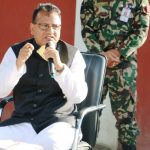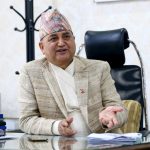Known as a key architect of the Maoist decade-long ‘People’s War’ and also a key actor in the peaceful transition, Dr Baburam Bhattarai has established himself as a popular leftist politician in Nepal. He has demonstrated remarkable success in his journey from an underground leader to the country’s head of executive in 2011. But, the recent trends suggest that his political strength is on the gradual decline.
Dr Baburam Bhattarai, being the SLC board first of 1970 and having earned a Ph. D, is a blue-eyed politician for the middle-class intelligentsia. Because of his analytic and visionary statements, Bhattarai has always garnered a huge public support during both underground and open politics. Unfortunately, the very image of the dreamlike figure is now gradually waning. As a result, he seems to be in a truly ‘Catch-22′ situation at the moment – paradoxically caught between the successful past and the confused future. The dwindling political clout of Bhattarai in the present scenario is not only his personal tragedy; it is also a misfortune of the nation too. Reasons behind his fall might be debated endlessly but what has become clear is that his leadership strategy in internal party politics has proved absolutely defective.
Bhattarai is a political actor, and his position and influence cannot continue unless he establishes a firm ground in a compatible political institution. There are some historical turning points associated with the rise and fall in his political standing. Bhattarai first came into the limelight when he led the critique of multi-party democracy in the 90s, as the party leader (Puspakamal Dahal ‘Prachanda’ was less known than him at that time) of the then CPN-Maoist. He was the one who submitted the much-hyped 40-point demand to then Prime Minister Sher Bahadur Deuba on 4 February 1996, threatening to wage an armed conflict if the demands were not met. Included in the list of the demands were end of domination of foreign capitals in Nepali industries, business and finance and scrapping the discriminatory treaties including the 1950 Nepal-India Treaty of Peace and Friendship and confiscating the land under the control of the feudal system and be distributed to the landless and the homeless. These demands helped Baburam to come into political forefront as a prominent and pro-people figure. The same became a tool to Bhattarai to earn popular support from intellectual circle including the middle-class urban residents. Immediately after forwarding the demands, Bhattarai’s party launched the “People’s War” and he went underground until the People’s Movement-II.
Despite being an architect of the ‘People’s War’ launched by his party, Bhattarai is always looked as a democratic and liberal communist figure, both within and outside his party. Many believe that Bhattarai was the key person who drove the Maoist movement into the peaceful and democratic process while the hardliner communists accuse him of collapsing the militancy of the rebel party
But, his introvert personality often disadvantaged him to act in his full intellectual capacity as a leader within the party and in the public too. At times, he is even suspected whether he has needed capacity to lead the party and the nation. This contradiction became particularly visible when he was heading the government during 2011-2013. As the Prime Minister of the country, Bhattarai was struck back with almost same list of demands (resembling his own 40-points demands) from his own fellow comrades who were disassociated from the UCPN (Maoist) to from the Mohan Baidhya-led CPN-Maoist. Though it was clear that such ‘revolutionary’ demands were beyond any means for Bhattarai to fulfill, he was unable to demonstrate a politics of engagement with radicals and liberals for a political transition – centered round drafting of the new constitution.
The contradiction further continued when as a prime minister of the country, Bhattarai against his own economic principle, struck a controversial ‘Bilateral Investment Promotion and Protection Agreement’ (BIPPA) deal with India that created a turmoil not only outside but also within his own party. The BIPPA which he light-heartedly defined as a ‘gambling’ further strengthened his critics who always defamed him as a pro-Indian leader.
Bhattarai didn’t stop there; he hastily deployed bulldozers to demolish the huts of homeless and landless squatters at Thapathali, on the bank of the Bagmati River in Kathmandu. His architectural wit and pro-poor political ideology was no more in his deed of destroying the squatters’ huts. This move was considered and publicized by his critics as an anti-proletariat, further weakening his grip in the party.
Bhattarai also failed to generate consent within his own party in many issues like army integration during his premiership. Though he had taken significantly positive move in army integration as part of the peace process, unfortunately the very decision undermined his position in his party. The discontent even led to the split in the party. The Nepali Congress and CPN-UML benefited from the frustration of the Maoist cadres and sympathizers in their favor during the 2nd CA elections held on November 19, 2013.
Still worse, the demise of the first Constituent Assembly (CA) without drafting a constitution during his premiership proved a backfire for Bhattarai. The failure of the first CA wasn’t just one among many political incidents happening in Nepal; it was probably the biggest historical incident in terms of the lost opportunity for the nation. It was most unfortunate day in the history of Nepal. The UCPN (Maoist) which established the demand for CA to settle the decade-long insurgency demised when the party led the government as the single largest party in the first CA. Though Bhattarai has always defended that the incident was inevitable due the Supreme Court’s order which prohibited the CA term extension but he is blamed mostly for the CA demise. With the CA failure fundamentally Bhattarai as a leader of the country failed to fulfill the duty of drafting the constitution through the historic CA in the leadership of his own party. Many of his critics blame Bhattarai for being a self-centered to remain at the helm of power at the cost of CA dismissal.
Bhattarai who failed to deliver a constitution from first CA also failed to hold the 2nd CA elections as announced twice without a political consent. Because of his failure, the nation had to go through unprecedented political situation. For the first time in the history, the head of the judiciary got an entry into the Singha Durbar as the head of the executive.
The only memorable task Bhattarai left as his legacy is the road expansion drive in Kathmandu valley. His decision to reconstruct the roads by stepping on a law that was formulated three decades ago is widely appreciated.
Baburam has always been in a leadership fight with party chairman Pushpa Kamal Dahal ‘Prachanda’ from the very beginning but has failed to engage with the latter politically. Many of his own party cadres have no faith on Bhattarai as a top leader despite the fact that all of them have realized Prachanda also does not hold a high calibre to lead the party. He tried to bring down Prachanda many times by using many disguised methods but always surrendered at the end to remain in second position in the party ranking.
As in the previous party meetings, Bhattarai boycotted the closed-session of party’s National Conference recently held in Biratnagar, citing ideological difference with party chairman Prachanda. But, unfortunately Bhattarai agreed to work together with the party establishment faction after the consensus in power sharing in the party central committee.
An introvert despite visionary personality, Bhattarai has continuously been awkward in the ways in which he pursues his political roles. Having spent years in a party as the chief ideologue, recently Bhattarai has come to a conclusion that Nepal needs a new political force but he himself seems much confused and has concealed his mission even in the public forums. He says a new political force should be based on a fusion of socialistic and capitalistic ideals which many have already cast their doubts. For many skeptical, his dream of new force is nothing but a manifestation of his suppressed interest to reach at the top position in the party, which he can never execute. His ‘new political force’ concept resembles recently founded Aam Admi Party (AAP) in India. But, the very concept also got a serious blow after the AAP’s shameful defeat in the recently held Lok Sabha Elections, against the sudden rise the AAP gained in the Bidhan Sabha Election in New Delhi. More fundamental question on Bhattarai is: how could a leader who has already become a prime minister of the country can become the leader of new force that is supposed to change the nation fundamentally?
In conclusion, Bhattarai has emerged as a major political science dilemma in Nepal. How can a leader fail when his or her ideas are still reining a major political party and the entire transitional politics of the country?





